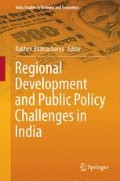Abstract
Chapter ten emphasizes an alternative approach in policy making for regional development from conventional ‘top-down’ to a joint effort of concerned stakeholders involved in public and private domains. As economic regions are not recognized with their potentials and endowments, development performance at regional levels therefore tends to remain lopsided, arbitrary and under-utilised with political and administrative boundaries. Some such regions may require a real competitive edge by finding niches or by mainstreaming endogenous ideas and knowledge. Many a time such economic differences are deeply linked with longstanding unequal power relations between leading and backward regions. Political representation from advanced Indian regions along with strong central intervention continued to dominate in the decision-making and policy formation process, which has aggravated growth-gaps and uneven development outcomes, eventually made it difficult for backward regions to ‘catch-up’ and many have manifested with social unrest and conflicts. Therefore, by assessing all economic, social and political context of regional development, a knowledge-based policy intervention in the low-performing regions is extremely crucial. An optimum choice of policy strategy connecting potentialities, linkages, political voice and various other dynamics that influence both the pattern of growth and social justice across the regions, needs to be found out. Thus, political sensitization, democratization, awakening and analyses of regional development in India need to be prioritized in policy recommendation to redress the imbalance between the strong and weak regions. Therefore along with decentralized governance, a multi-level federalism, by transferring power to the local, regional and territorial levels, may be an important tool as local political institutions can better understand the aspirations and uniqueness of the local situations and can represent and respond adequately to their needs and demands.
Access this chapter
Tax calculation will be finalised at checkout
Purchases are for personal use only
Notes
- 1.
To be eligible for performance grants, the gram panchayats will have to submit audited annual accounts that relate to a year not earlier than 2 years preceding the year in which the gram panchayat seeks to claim the performance grant.
- 2.
For equity and efficiency concepts, see Report on National Strategy of Regional Development: Regions, Cities, Rural Areas, Warsaw 2010.
- 3.
Government of India has set up an expert committee (2013) under the chairmanship of Chief Economic Advisor Raghuram Rajan to draw up a composite development index of individual states. The index that is focused on shedding light about backward states intends studying individual state’s progress vis-a-vis national progress on criteria such as per capita income and other human development indicators.
- 4.
World Development Report (2013) has recognized jobs as the cornerstone of economic and social development.
- 5.
Vertical dimension refers to the linkages between higher and lower levels of government, including their institutional, financial and informational aspects. Horizontal dimension refers to cooperation arrangements between regions or between municipalities.
References
Charbit, C. 2011. Governance of public policies in decentralised contexts: The multi-level approach. OECD Regional Development Working Papers, 2011/04, OECD Publishing. http://dx.doi.org/10.1787/5kg883pkxkhc-en. Accessed 20 Apr 2013.
Election Commission of India. 2009. Election Commission of India, General Elections, 2009 (15th Lok Sabha) at http://eci.nic.in/eci_main/archiveofge2009/Stats/VOLI/03_NumberAndTypeOfConstituencies.pdf. Accessed 25 may 2013.
Election Commission of India. 2014. Election Commission of India, General Elections Schedule, 2014 (16th Lok Sabha) at http://eci.nic.in/eci_main1/GE2014/Schedule/Home.htm.
FAQs- Delimitation of Constituencies, Election Commission of India. 2014. Available via http://eci.nic.in/eci_main1/delimitation_faq.aspx. Accessed 21 Apr 2013.
Gradus, Yehuda. 1983. The role of politics in regional inequality: The Israeli case. Annals of the Association of American Geographers 73 (3): 388–403.
Luger, M. I., and Maynard N. C. 2008. On the government's role in regional economic development. In Public policy for regional development, ed. J. Martinez-Vazquez, and F. Vaillancourt, 28–46. New York: Routledge.
Martinez-Vazquez, Jorge, and Francois, Vaillancourt, ed. 2008. Public policy for regional development. New York: Routledge.
Massey, D. 2001. The progress in human geography lecture, geography on the agenda. Progress in Human Geography 25 (1): 5–17.
Nijkamp, Peter. 2012. Regional development: Education and integration. Indian Journal of Regional Science 44 (1): 1–10.
Pscharopoulos, George, and Harry Anthony, Patrinos. 1994. Indigenous people and poverty in Latin America: An empirical analysis. Washington, D. C.: The World Bank.
Report. 2006. World Development Report: Equity and Development. Washington, D. C.: The World Bank.
Report. 2010. National strategy of regional development: Regions, cities, rural areas, 2010–2020. Warsaw. Ministry of Regional Development.
Report. 2013. World Development Report. Washington, D.C: The world Bank
Statistical Report on General Elections. 1999. Statistical Report on General Elections, 1999 to the Thirteenth Lok Sabha Volume I, Election Commission of India at http://eci.nic.in/eci_main/SR_KeyHighLights/LS_1999/Vol_I_LS_99.pdf.
Author information
Authors and Affiliations
Corresponding author
Editor information
Editors and Affiliations
Rights and permissions
Copyright information
© 2015 Rajiv Gandhi Institute for Contemporary Studies
About this chapter
Cite this chapter
Bhattacharya, R. (2015). The Way Forward: Public Policy to Address Regional Imbalances in India, Process and Outcome. In: Bhattacharya, R. (eds) Regional Development and Public Policy Challenges in India. India Studies in Business and Economics. Springer, New Delhi. https://doi.org/10.1007/978-81-322-2346-7_10
Download citation
DOI: https://doi.org/10.1007/978-81-322-2346-7_10
Published:
Publisher Name: Springer, New Delhi
Print ISBN: 978-81-322-2345-0
Online ISBN: 978-81-322-2346-7
eBook Packages: Business and EconomicsEconomics and Finance (R0)

